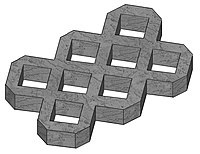Joint vegetation
When joints vegetation , also paving Ritz vegetation are plants referred to in the joints of paved surfaces grow. This vegetation is one of the ruderal microhabitats in the area of human settlements.
In many cases, joint vegetation is treated with herbicides or other measures, e.g. B. Scraping, combats. On the other hand, paving , which deliberately keeps joints open for settlement by plants, is increasingly being used to reduce soil sealing . Special growth conditions prevail in the joints to which only certain plants can adapt. Dense growth in the joints of the cobblestones increases its strength. In addition, this type of greening is becoming more and more important for urban ecology , not only for reasons of urban design, but also for rainwater management .
layout
New ways of laying the pavement offer creative leeway and greater space for the vegetation. These types of plasters include, for example:
Location characteristics
Only a few centimeters deep and even smaller widths offer the plants extremely little space to develop the leaves or roots . The soil in the joints cannot provide the plants with enough nutrients either. The plants can only absorb nutrients by being blown or flushed in. The nitrogen input from exhaust gases ( nitrogen oxides and ammonia ) and waste in settlement areas can be very high.
The joints are active in seepage and, when it rains, absorb all the water from the much larger surface of the pavement. This usually ensures sufficient moisture despite the small surface area of the joints and cracks.
Adaptability
Pavement crack vegetation is characterized by the fact that the plants in the joints are very resistant to unfavorable location factors .
The first adjustment feature is the size of the carpels and roots . Since the cracks are only a few centimeters wide and deep, roots can only be minimally grown. This means that the roots stop just below the surface. Overall, the nutrient uptake is only possible to a limited extent, since extreme fluctuations in the nutrient level take place in the patches. This is the reason for the small size of the plants. In a different environment, however, the same plants can reach far larger dimensions, i.e. the characteristics are phenotypic .
In addition to the scarce supply of nutrients, there is the mechanical stress on the leaves due to the “ representation ” of the users of these paths. A soil compaction is often the result.
Species composition
Besides lichens and mosses such as the silver moss ( Bryum argenteum ) come in Central Europe depending on location grasses such as the German ryegrass ( Lolium perenne ) and the Annual bluegrass ( Poa annua ), the plantain ( Plantago major ) that chickweed ( Stellaria media ), the Perching masthead ( Sagina procumbens ), the white clover ( Trifolium repens ) and dandelion species in the joint vegetation.
tries
In some large cities such as Berlin, Vienna and Paris, as well as at the Weihenstephan Science Center , tests were carried out with the pavement crack vegetation.
In Margareten , one of the most densely populated districts of Vienna , seed mixtures have been tested since spring 2005. The cracks between the cobblestones of a large parking lot were not sealed, but filled with sand to which the seeds had been added. In cooperation with the University of Natural Resources and Life Sciences , care was taken to ensure that the plants were low-growing. For reasons of traffic safety, only heights of up to two centimeters are permitted on traffic areas.
During the tests it was found that only parking areas are suitable for the joint vegetation that are rarely used, at most once or twice a day. It also turned out that the frost damage caused by the water penetrating the joints is much higher than on tightly sealed surfaces.
literature
- Herbert Sukopp and Rüdiger Wittig: Urban Ecology - A textbook for study and practice . Gustav Fischer Verlag, Stuttgart, 1998 ISBN 3-437-26000-6
Web links
- Jürgen Eppel: New research results in rainwater management . fbr conference, Frankfurt am Main, 2003 (PDF; 818 kB)
- ORF-Vienna: Report on an attempt in Vienna-Margareten

